Sandeep Subramanian
Pixtral 12B
Oct 09, 2024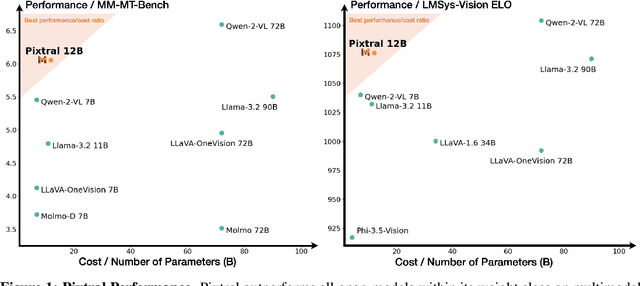
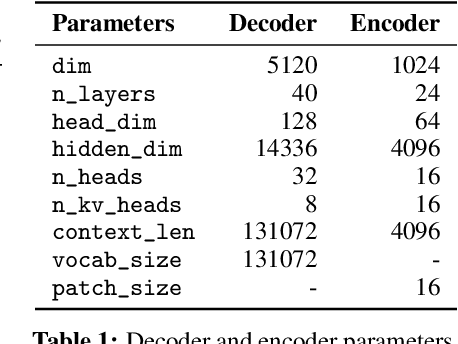
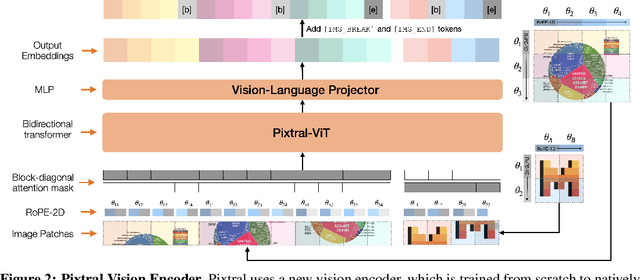
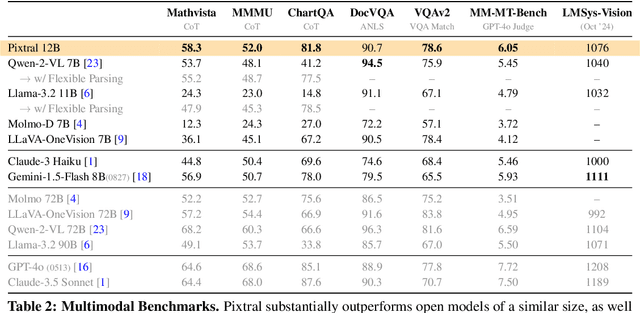
Abstract:We introduce Pixtral-12B, a 12--billion-parameter multimodal language model. Pixtral-12B is trained to understand both natural images and documents, achieving leading performance on various multimodal benchmarks, surpassing a number of larger models. Unlike many open-source models, Pixtral is also a cutting-edge text model for its size, and does not compromise on natural language performance to excel in multimodal tasks. Pixtral uses a new vision encoder trained from scratch, which allows it to ingest images at their natural resolution and aspect ratio. This gives users flexibility on the number of tokens used to process an image. Pixtral is also able to process any number of images in its long context window of 128K tokens. Pixtral 12B substanially outperforms other open models of similar sizes (Llama-3.2 11B \& Qwen-2-VL 7B). It also outperforms much larger open models like Llama-3.2 90B while being 7x smaller. We further contribute an open-source benchmark, MM-MT-Bench, for evaluating vision-language models in practical scenarios, and provide detailed analysis and code for standardized evaluation protocols for multimodal LLMs. Pixtral-12B is released under Apache 2.0 license.
Nemotron-4 340B Technical Report
Jun 17, 2024



Abstract:We release the Nemotron-4 340B model family, including Nemotron-4-340B-Base, Nemotron-4-340B-Instruct, and Nemotron-4-340B-Reward. Our models are open access under the NVIDIA Open Model License Agreement, a permissive model license that allows distribution, modification, and use of the models and its outputs. These models perform competitively to open access models on a wide range of evaluation benchmarks, and were sized to fit on a single DGX H100 with 8 GPUs when deployed in FP8 precision. We believe that the community can benefit from these models in various research studies and commercial applications, especially for generating synthetic data to train smaller language models. Notably, over 98% of data used in our model alignment process is synthetically generated, showcasing the effectiveness of these models in generating synthetic data. To further support open research and facilitate model development, we are also open-sourcing the synthetic data generation pipeline used in our model alignment process.
Nemotron-4 15B Technical Report
Feb 27, 2024



Abstract:We introduce Nemotron-4 15B, a 15-billion-parameter large multilingual language model trained on 8 trillion text tokens. Nemotron-4 15B demonstrates strong performance when assessed on English, multilingual, and coding tasks: it outperforms all existing similarly-sized open models on 4 out of 7 downstream evaluation areas and achieves competitive performance to the leading open models in the remaining ones. Specifically, Nemotron-4 15B exhibits the best multilingual capabilities of all similarly-sized models, even outperforming models over four times larger and those explicitly specialized for multilingual tasks.
Mixtral of Experts
Jan 08, 2024



Abstract:We introduce Mixtral 8x7B, a Sparse Mixture of Experts (SMoE) language model. Mixtral has the same architecture as Mistral 7B, with the difference that each layer is composed of 8 feedforward blocks (i.e. experts). For every token, at each layer, a router network selects two experts to process the current state and combine their outputs. Even though each token only sees two experts, the selected experts can be different at each timestep. As a result, each token has access to 47B parameters, but only uses 13B active parameters during inference. Mixtral was trained with a context size of 32k tokens and it outperforms or matches Llama 2 70B and GPT-3.5 across all evaluated benchmarks. In particular, Mixtral vastly outperforms Llama 2 70B on mathematics, code generation, and multilingual benchmarks. We also provide a model fine-tuned to follow instructions, Mixtral 8x7B - Instruct, that surpasses GPT-3.5 Turbo, Claude-2.1, Gemini Pro, and Llama 2 70B - chat model on human benchmarks. Both the base and instruct models are released under the Apache 2.0 license.
Retrieval meets Long Context Large Language Models
Oct 04, 2023



Abstract:Extending the context window of large language models (LLMs) is getting popular recently, while the solution of augmenting LLMs with retrieval has existed for years. The natural questions are: i) Retrieval-augmentation versus long context window, which one is better for downstream tasks? ii) Can both methods be combined to get the best of both worlds? In this work, we answer these questions by studying both solutions using two state-of-the-art pretrained LLMs, i.e., a proprietary 43B GPT and LLaMA2-70B. Perhaps surprisingly, we find that LLM with 4K context window using simple retrieval-augmentation at generation can achieve comparable performance to finetuned LLM with 16K context window via positional interpolation on long context tasks, while taking much less computation. More importantly, we demonstrate that retrieval can significantly improve the performance of LLMs regardless of their extended context window sizes. Our best model, retrieval-augmented LLaMA2-70B with 32K context window, outperforms GPT-3.5-turbo-16k and Davinci003 in terms of average score on seven long context tasks including question answering and query-based summarization. It also outperforms its non-retrieval LLaMA2-70B-32k baseline by a margin, while being much faster at generation. Our study provides general insights on the choice of retrieval-augmentation versus long context extension of LLM for practitioners.
Finding the Right Recipe for Low Resource Domain Adaptation in Neural Machine Translation
Jun 02, 2022
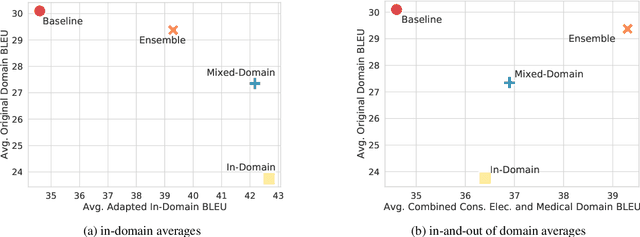
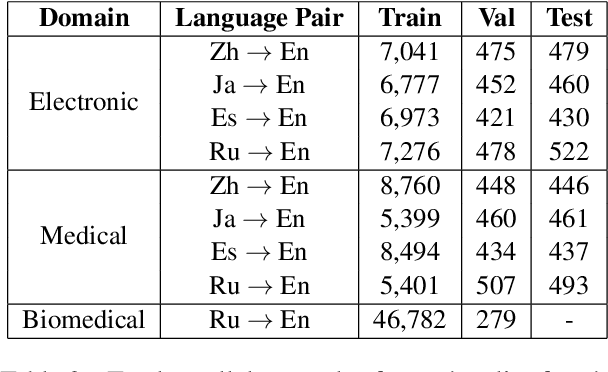

Abstract:General translation models often still struggle to generate accurate translations in specialized domains. To guide machine translation practitioners and characterize the effectiveness of domain adaptation methods under different data availability scenarios, we conduct an in-depth empirical exploration of monolingual and parallel data approaches to domain adaptation of pre-trained, third-party, NMT models in settings where architecture change is impractical. We compare data centric adaptation methods in isolation and combination. We study method effectiveness in very low resource (8k parallel examples) and moderately low resource (46k parallel examples) conditions and propose an ensemble approach to alleviate reductions in original domain translation quality. Our work includes three domains: consumer electronic, clinical, and biomedical and spans four language pairs - Zh-En, Ja-En, Es-En, and Ru-En. We also make concrete recommendations for achieving high in-domain performance and release our consumer electronic and medical domain datasets for all languages and make our code publicly available.
NVIDIA NeMo Neural Machine Translation Systems for English-German and English-Russian News and Biomedical Tasks at WMT21
Nov 16, 2021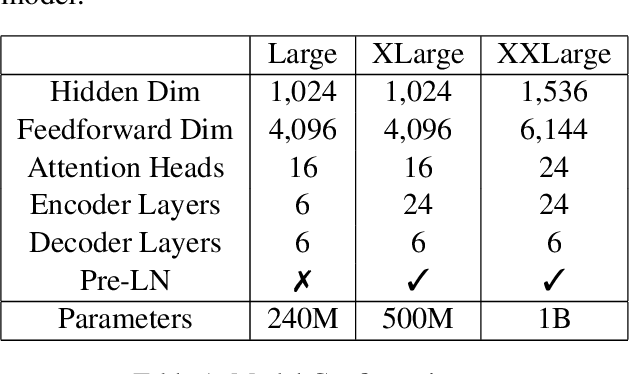
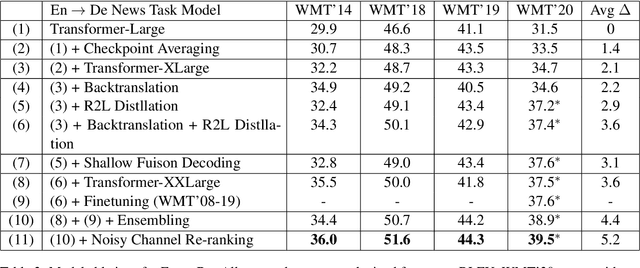


Abstract:This paper provides an overview of NVIDIA NeMo's neural machine translation systems for the constrained data track of the WMT21 News and Biomedical Shared Translation Tasks. Our news task submissions for English-German (En-De) and English-Russian (En-Ru) are built on top of a baseline transformer-based sequence-to-sequence model. Specifically, we use a combination of 1) checkpoint averaging 2) model scaling 3) data augmentation with backtranslation and knowledge distillation from right-to-left factorized models 4) finetuning on test sets from previous years 5) model ensembling 6) shallow fusion decoding with transformer language models and 7) noisy channel re-ranking. Additionally, our biomedical task submission for English-Russian uses a biomedically biased vocabulary and is trained from scratch on news task data, medically relevant text curated from the news task dataset, and biomedical data provided by the shared task. Our news system achieves a sacreBLEU score of 39.5 on the WMT'20 En-De test set outperforming the best submission from last year's task of 38.8. Our biomedical task Ru-En and En-Ru systems reach BLEU scores of 43.8 and 40.3 respectively on the WMT'20 Biomedical Task Test set, outperforming the previous year's best submissions.
Multi-scale Transformer Language Models
May 01, 2020



Abstract:We investigate multi-scale transformer language models that learn representations of text at multiple scales, and present three different architectures that have an inductive bias to handle the hierarchical nature of language. Experiments on large-scale language modeling benchmarks empirically demonstrate favorable likelihood vs memory footprint trade-offs, e.g. we show that it is possible to train a hierarchical variant with 30 layers that has 23% smaller memory footprint and better perplexity, compared to a vanilla transformer with less than half the number of layers, on the Toronto BookCorpus. We analyze the advantages of learned representations at multiple scales in terms of memory footprint, compute time, and perplexity, which are particularly appealing given the quadratic scaling of transformers' run time and memory usage with respect to sequence length.
On Extractive and Abstractive Neural Document Summarization with Transformer Language Models
Sep 07, 2019



Abstract:We present a method to produce abstractive summaries of long documents that exceed several thousand words via neural abstractive summarization. We perform a simple extractive step before generating a summary, which is then used to condition the transformer language model on relevant information before being tasked with generating a summary. We show that this extractive step significantly improves summarization results. We also show that this approach produces more abstractive summaries compared to prior work that employs a copy mechanism while still achieving higher rouge scores. Note: The abstract above was not written by the authors, it was generated by one of the models presented in this paper.
Do Neural Dialog Systems Use the Conversation History Effectively? An Empirical Study
Jun 04, 2019


Abstract:Neural generative models have been become increasingly popular when building conversational agents. They offer flexibility, can be easily adapted to new domains, and require minimal domain engineering. A common criticism of these systems is that they seldom understand or use the available dialog history effectively. In this paper, we take an empirical approach to understanding how these models use the available dialog history by studying the sensitivity of the models to artificially introduced unnatural changes or perturbations to their context at test time. We experiment with 10 different types of perturbations on 4 multi-turn dialog datasets and find that commonly used neural dialog architectures like recurrent and transformer-based seq2seq models are rarely sensitive to most perturbations such as missing or reordering utterances, shuffling words, etc. Also, by open-sourcing our code, we believe that it will serve as a useful diagnostic tool for evaluating dialog systems in the future.
 Add to Chrome
Add to Chrome Add to Firefox
Add to Firefox Add to Edge
Add to Edge